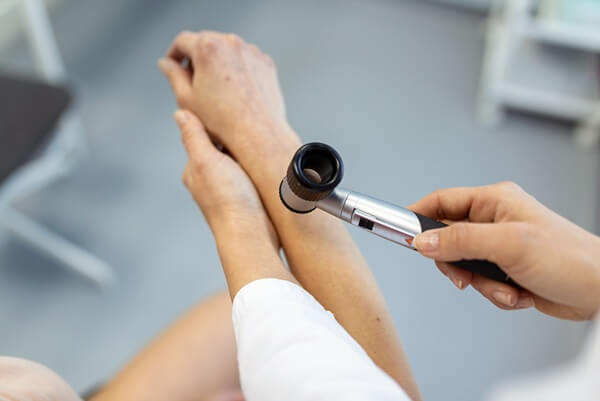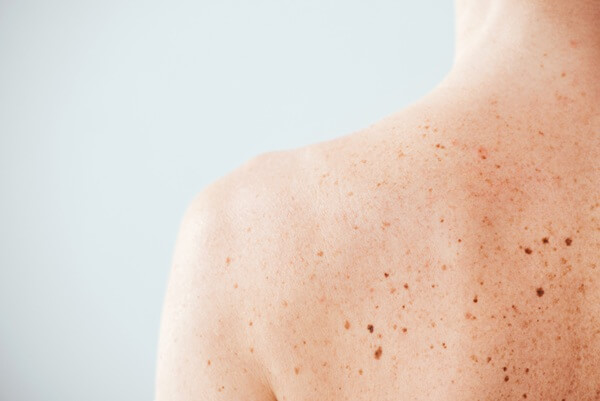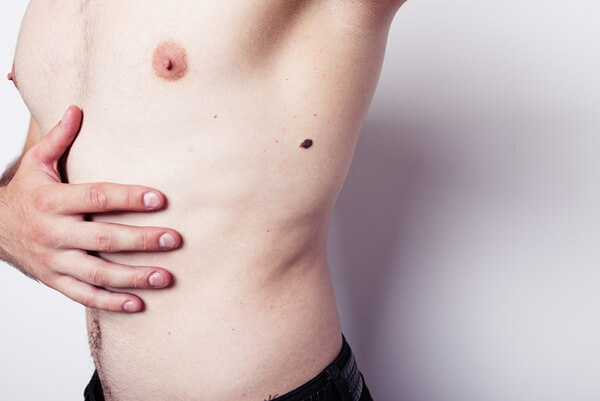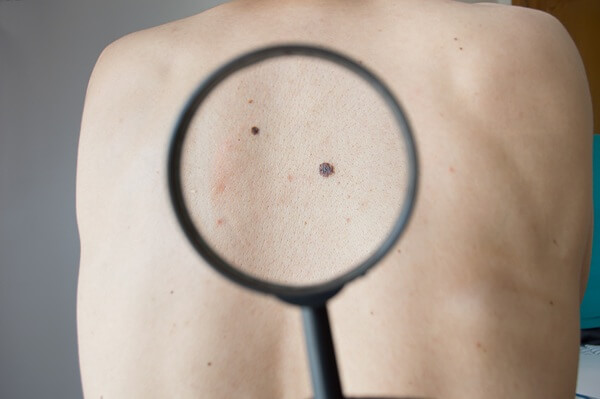

No matter your skin type, we can teach you the best way to care for your skin. That’s why we believe everyone should examine their skin thoroughly. This is a good way to do skin disease control and detect a suspicious mole, skin lesion, or any other suspicious spot that could develop into a harmful condition.
The first step for most of our patients involves thorough evaluations of their skin in-office, affectionately called skin checks. Through these checks, you and a dermatologist can note all the potential areas for concern at their early stages and provide yourself with skin cancer prevention measures all year-round.


A skin check is a thorough screening of your body to check for signs of skin cancers like melanoma, unusual moles, and other suspicious signs that may suggest a skin disorder or different skin cancer types. The Skin Cancer Foundation recommends that everyone:
Melanoma and other forms of skin cancers can often look like benign moles or grow inside existing moles, so it can be difficult to spot by everyday people. However, by conducting monthly checks, you can easily spot these blemishes on your skin and have them checked by a dermatologist to determine if these are cancerous skin cells or otherwise.
By catching these early, you can prevent your cancer from progressing. Taking skin cancer screening steps like mole mapping and regular skin check consultations are essential to catch skin cancer cells within its earliest stages and stop it from spreading to other skin cells and nearby organs. That's why it's important for you to conduct regular self-examinations of your skin to detect potential skin cancer early on when it’s more easily treatable.

At Dermatology & Skin Health, we offer world-class services done by award-winning doctors who have proven their knowledge and skills in this field. Start your journey towards achieving your best skin by contacting us today.

Most melanomas are caused by sun exposure beginning in childhood. Melanoma cancer also runs in families. It can be diagnosed via a biopsy, where your dermatologist can determine your condition and the best solution to remove the cancer cells. Treatments include surgical removal of the cancer cells, radiation therapy, or chemotherapy.
The key to detecting skin cancers is to notice changes in your skin. If you see any of these signs, schedule an appointment with Dermatology & Skin Health’s medical professionals for a more comprehensive skin check:
The American Academy of Dermatology has developed the following ABCDEs of Melanoma guide for assessing whether or not a mole or other lesion may be becoming cancerous. Schedule an appointment with a dermatologist in the nearest Dermatology & Skin Health location near you if you find a pigmented spot or mole that has the following.
At least once a month, you’ll want to examine your body thoroughly. First, using a full-length mirror, examine your body from the front and back and then on the sides with your arms raised. Next, check your underarms, forearms, palms, and elbows. Next, sit down and check your legs, toes, and soles. Lastly, examine around your neck, scalp, back, and butt using a hand mirror.
While checking, you should be taking note of anything that can appear new, changing, or unusual on your skin. This can include:

At Dermatology & Skin Health, our excellent dermatology services are guaranteed to be safe and effective, performed by the top doctors in their respective fields. Treat your skin problems by contacting us today.

If there are any noticeably unusual moles or signs mentioned above, keep track of them and schedule an appointment with a dermatologist. They can determine if this spot is cancerous or benign and if treatment is necessary.
During your self-exam, you may discover some anomalies that may be a cause for concern. In case you see any of these, you should schedule an appointment with a dermatologist. They can determine if your mole or spot is basal cell carcinoma, a squamous cell carcinoma, or melanoma.
Basal and squamous cells are common forms of skin cancer also known as non melanoma skin cancers. These develop at the outermost layers of the skin that’s prone to exposure from UV rays, particularly your face, ears, and neck. Those who are bald can also commonly find it on their scalp.
Basal cell carcinoma appears as a singular pearly bump, while squamous cell carcinoma is a reddish and ulcerated bump that’s prone to bleeding. These two are slow to spread and, if left untreated, can disfigure your skin. However, when caught early, it can be cured and treated.
Melanoma, on the other hand, is a more serious form of skin cancer and can appear from or near an existing mole. These are more commonly found on your back, legs, head, and neck. If left untreated, this cancer can spread to your internal organs. But if caught early, it can be treated.
At Dermatology & Skin Health, we strongly recommend taking skin cancer prevention measures to catch potential signs of skin cancers early. If you’ve conducted a self-exam and found areas of concern or want to learn more about thorough self-exams, please make an appointment to see one of our providers right away. A biopsy of the mole may be necessary to determine if it is or isn't cancerous.
We have 4 locations: Dover, Portsmouth, Londonderry, NH, and Peabody, MA. You can schedule your comprehensive skin checks in any of these locations. To set up your appointment, request one online or give us a call at (603) 742-5556 (Dover & Portsmouth), (978) 525-0100 (Peabody), (603) 965-3551 (Londonderry), or (603) 742-5556 (Bedford).

At Dermatology & Skin Health, we offer world-class services done by award-winning doctors who have proven their knowledge and skills in this field. Start your journey towards achieving your best skin by contacting us today.
If your desired appointment type or preferred provider is unavailable online, kindly call (978) 525-0100 for Peabody, MA and (603) 742-5556 for all New Hampshire locations. Alternatively please feel free to send us your request via the patient portal, or via email at info@dermskinhealth.com
*For medical dermatology appointments in MA please dial (978) 525-0100 or fill out the appointment request form above.